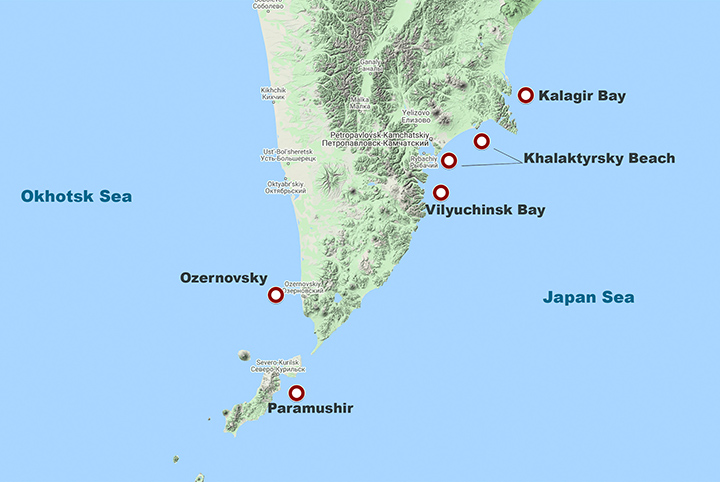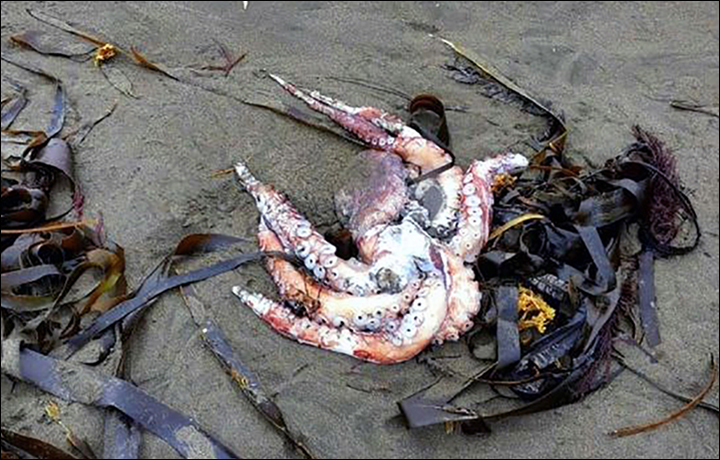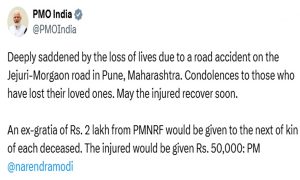A dozen deep-sea giant octopuses washed ashore at the island of Paramushir, Northern Kuril Islands, 300km south from the Kamchatka peninsula where people continue to report mass death of marine animals.
This was the second ‘octopi tide’ filmed by residents of Severo-Kurilsk at the Island of Paramushir .
The first mass death of octopuses, sea urchins, crabs and shells was reported five days earlier on 2 October.
‘The coast is covered with dead octopuses, sea urchins, crabs, mollusk and flounder.
‘Unlikely it was caused by a storm, we have bad weather every other day and no sea animals are thrown out like this on a mass scale’.

A day earlier another case of mass death of marine wildlife was reported by a resident of Ozerkovsky village by the Sea of Okhotsk on the western coast of the Kamchatka peninsula.
The new case is some 371km land distance away (further by the sea) from Petropavlovsk-Kamchatsky, where first deaths of marine animals were flagged by the local surfers community at the beginning of September.
‘We are faced with a massive new phenomenon which science is yet to comprehend’, governor of Kamchatka Vladimir Solodov commented on the Sea of Okhtosk marine death report.
Earlier the governor called for international researchers from leading universities in the USA, Japan and China to join the investigation of the major environmental catastrophe that caused the mass death of marine life off the coast of the Kamchatka peninsula.
‘The Kamchatka region faces a challenging environmental situation which involves the mass death of marine animals and hydrobionts in Avacha Bay of the Pacific Ocean.
‘The causes of this phenomenon remain unclear.
‘We invite you to consider the possibility of joining the research group and help us to identify the causes of the pollution of the Pacific Ocean near Kamchatka.
‘The research group will work remotely and examine the available analyses results and hypotheses of our scientists’, Vladimir Solodov wrote in his appeal to the scientists.
So far several groups of Russian scientists said that according to their research it was the so-called Red Tide – the rapid activation of toxic algae – that killed marine life.
Water samples showed high levels of micro-algae which release toxins when blooming, thus depleting water of oxygen and harming invertebrates, said vice president of Russian Academy of Sciences Andrey Adrianov.
‘There is no clarity yet, but the toxic algae version is taking a lead. One of our next tasks would be to organise expeditions to find out what led to the activation of the algae’, said Alexey Ozerov, director of Kamchatka-based Institute of Volcanology and Seismology.
The Red Tide version is nothing but a speculation without a documented proof of toxins in the tissues of the affected marine animals, Doctor of Biology, professor of the Department of Ecology and Nature Management of the Kamchatka State Technical University Tatiana Klochkova told RBC.
‘Without detecting toxins in the animals organs and tissues talks about microalgae is speculation. However, this summer was abnormally warm for Kamchatka with a high number of sunny days which could have provoked an outbreak of plankton blooming’, Klochkova said.
Another – unnamed – scientist involved in studying the affected waters of the Pacific Ocean said that he found no trace of micro-algae in the sea.
Russian scientists have so far discounted versions of leaked waste from Koselsky and Radygino military waste sites, leaked rocket fuel, seismic or volcanic activity and waste water from ships causing environmental damage.
The Russian Investigative Committee has opened a criminal case into the eye damage suffered by leading surfer Mayi Rudik, 36, after training at the Khalaktyrsky beach outside Petropavlocsk-Kamchatsky.
More than 400 surfers have trained at the beach, with dozens of them reporting worsening eyesight, fever, diarrhea, nausea, vomiting, skin rashes and head and throat aches.
Mayi posted videos of the yellowish foam at the Khalaktyrsky beach filmed at the end of September.




























 WhatsApp us
WhatsApp us